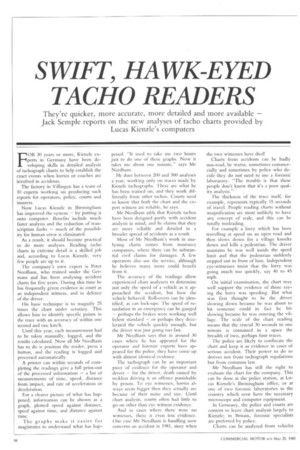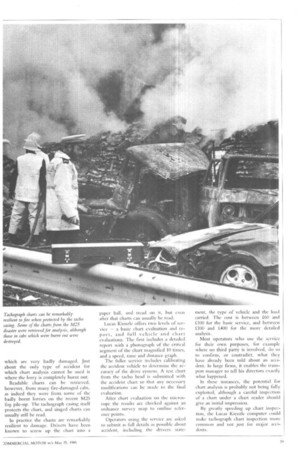SWIFT, HAWK-EYED TACHO READERS
Page 60

Page 61

If you've noticed an error in this article please click here to report it so we can fix it.
They're quicker, more accurate, more detailed and more available — Jack Semple reports on the new analyses of tacho charts provided by Lucas Kienzle's computers
FOR 30 years or more, Kienzle experts in Germany have been developing skills in detailed analysis of tachograph charts to help establish the exact events when lorries or coaches are involved in accidents.
The factory in Villingen has a team of 10 experts working on producing such reports for operators, police, courts and insurers.
Now Lucas Kienzle in Birmingham has improved the system — by putting it onto computer. Benefits include much faster analysis and the reduction of transcription faults — much of the possibility for human error is eliminated.
As a result, it should become practical to do more analyses. Reading tacho charts in extreme detail is a skilled job and, according to Lucas Kienzle, very few people are up to it.
The company's own expert is Peter Needham, who trained under the Germans and has been analysing accident charts for five years. During this time he has frequently given evidence in court as an independent witness, and in defence of the driver.
His basic technique is to magnify 25 times the chart under scrutiny. This allows him to identify specific points in the trace with an accuracy of within one second and one km/h.
Until this year, each measurement had to be taken manually, logged, and the results calculated. Now all Mr Needham has to do is position the reader, press a button, and the reading is logged and processed automatically.
A printer can within seconds of completing the readings give a full print-out of the processed information — a list of measurements of time, speed, distance from impact, and rate of acceleration or deceleration.
For a clearer picture of what has happened, information can be shown as a graph, plotted speed against distance, speed against time, and distance against time.
The graphs make it easier for magistrates to understand what has hap pened. "It used to take me two hours just to do one of these graphs. Now it takes me about one minute," says Mr Needham.
He does between 200 and 300 analyses a year, working only on traces made by Kienzle tachographs. These are what he has been trained on, and they work differently from other tachos. Courts need to know that both the chart and the expert witness are reliable, he says.
Mr Needham adds that Kienzle tachos have been designed partly with accident analysis in mind, and he claims that they are more reliable and detailed in a broader spread of accidents as a result.
Most of Mr Needham's work in analysing charts comes from insurance companies, where there can be substantial civil claims for damages. A few operators also use the service, although he believes many more could benefit from it.
The accuracy of the readings allow experienced chart analysers to determine not only the speed of a vehicle as it approached the accident, but how the vehicle behaved. Roll-overs can be identified, as can lock-ups. The speed of retardation in an emergency can be gauged — perhaps the brakes were working well below standard — or perhaps they decelerated the vehicle quickly enough, but the driver was just going too fast.
Mr Needham says that in around 30 cases where he has appeared for the operator and forensic experts have appeared for the police, they have come up with almost identical evidence.
The tachograph can be an important piece of evidence for the operator and driver — for the driver, death caused by reckless driving is an offence punishable by prison. To eye witnesses, lorries always seem bigger then they actually are because of their noise and size. Until chart analysis, courts often had little to go on other than eye witness evidence.
And in cases where there were no witnesses, there is even less evidence. One case Mr Needham is handling now concerns an accident in 1981, since when the two witnesses have died!
Charts from accidents can be badly mis-read, he warns, sometimes commercially and sometimes by police who decide they do not need to use a forensic laboratory. "The trouble is that these people don't know that it's a poor quality analysis."
The thickness of the trace itself, for example, represents typically 15 seconds of travel. People reading charts without magnification are most unlikely to have any concept of scale, and this can be totally misleading.
For example a lorry which has been travelling at speed on an open road and then slows down for a village knocks down and kills a pedestrian. The driver manta ins he was well inside the speed limit and that the pedestrian suddenly stepped out in front of him. Independent eye-witnesses insist that the lorry was going much too quickly, say 40 to 45 mph.
On initial examination, the chart may well support the evidence of those saying the lorry was speeding. But what was first thought to be the driver slowing down because he was about to hit someone could in fact be his slowing because he was entering the village. The scale of the chart reading means that the crucial 30 seconds to one minute is contained in a space the breadth of two, perhaps four traces.
The police are likely to confiscate the chart and keep it as evidence in cases of serious accident. Their power to do so derives not from tachograph regulations but from common law.
Mr Needham has still the right to evaluate the chart for the company. This can he done at the police station, at Lucas Kienzle's Birmingham office, or at one of two forensic laboratories in the country which now have the necessary microscope and computer equipment.
In Germany, the police and courts are content to leave chart analysis largely to Kienzle; in Britain, forensic specialists are preferred by police.
Charts can be analysed from vehicles which are very badly damaged. Just about the only type of accident for which chart analysis cannot he used is where the lorry is completely burnt out.
Readable charts can he retrieved, however, from many fire-damaged cabs, as indeed they were from some of the badly burnt lorries on the recent M25 fog pile-up. The tachograph casing itself protects the chart, and singed charts can usually still be read.
In practice the charts are remarkably resilient to damage. Drivers have been known to screw up the chart into a paper ball, and tread on it, but even after that charts can usually be read.
Lucas Kienzle offers two levels of service — a basic chart evaluation and report, and full vehicle and chart evaluations. The first includes a detailed report with a photograph of the critical segment of the chart magnified 10 times, and a speed, time and distance graph. The fuller service includes calibrating the accident vehicle to determine the accuracy of the drive system. A test chart from the tacho head is submitted with the accident chart so that any necessary modifications can be made to the final evaluation.
After chart evaluation on the microscope the results are checked against an ordnance survey map to outline reference points.
Operators using the service are asked to submit as full details as possible about accident, including the drivers state
ment, the type of vehicle and the load carried. The cost is between ,00 and i100 for the basic service, and between S:100 and 1400 for the more detailed analysis.
Most operators who use the service for their own purposes, for example where no third party is involved, do so to confirm, or contradict, what they have already been told about an accident. In large firms, it enables the transport manager to tell his directors exactly what happened.
In these instances, the potential for chart analysis is probably not being fully exploited, although a careful inspection of a chart under a chart reader should give an initial impression.
By greatly speeding up chart inspection, the Lucas KiCLIZIC computer could make tachograph chart inspection more common and not just for major accidents.












































































































